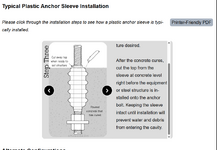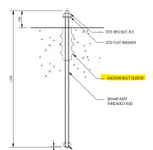Navigation
Install the app
How to install the app on iOS
Follow along with the video below to see how to install our site as a web app on your home screen.
Note: This feature may not be available in some browsers.
More options
Style variation
-
Congratulations MintJulep on being selected by the Eng-Tips community for having the most helpful posts in the forums last week. Way to Go!
You are using an out of date browser. It may not display this or other websites correctly.
You should upgrade or use an alternative browser.
You should upgrade or use an alternative browser.
Anchor Bolt Sleeves 1
- Thread starter EngDM
- Start date
I've never seen one used in a cast-in situation. The screen tube sleeves for adhesive anchors in masonry, sure, but not like this.
Maybe it's an attempt to debond a length of the anchor from the concrete? Thread on the topic.
Maybe it's an attempt to debond a length of the anchor from the concrete? Thread on the topic.
JoshPlumSE
Structural
They don't increase strength at all. At least not that I'm aware of.
What I believe they're used for is to help give the bolts some "wiggle" when you are placing equipment. Think of a 15 ft diameter vessel or tower with 20 of these fairly large diameter bolts. They are a pain in the butt to line up properly....
After the vessel is placed, you will typically fill the sleeve with grout.
What I believe they're used for is to help give the bolts some "wiggle" when you are placing equipment. Think of a 15 ft diameter vessel or tower with 20 of these fairly large diameter bolts. They are a pain in the butt to line up properly....
After the vessel is placed, you will typically fill the sleeve with grout.
HTURKAK
Structural
- Jul 22, 2017
- 3,371
This is a partial length sleeve which is is used for precise alignment of anchors which maybe required during installation equipment and preloading rarely. In general full length sleeve used for preloaded anchors. Preloading is necessary for vibrating equipment anchorage and when anchor is subject to dynamic loading .
This is a long story.
Pls look to the doc. at the following website to get more info..
This is a long story.
Pls look to the doc. at the following website to get more info..
Attachments
- Thread starter
- #5
I'm curious why they are showing it ribbed like that. If it was to debond the concrete, then I'd imagine you'd want the sleeve to not grip the concrete at all, but with the ribs and grouting it after there will be some force transfer. I'm thinking @JoshPlumSE is on the right track, but this is a pretty typical W column baseplate with only 8 anchors, so not sure why they'd need this; they could cut a simple template out of plywood and use that as their reference.
JoshPlumSE
Structural
EngDM: I'm thinking @JoshPlumSE is on the right track, but this is a pretty typical W column baseplate with only 8 anchors, so not sure why they'd need this; they could cut a simple template out of plywood and use that as their reference.
Yeah, I don't think it's generally needed for such situations. I can see how some contractors my LIKE it because it does make alignment easier for all situations. So, a contractor who got majorly dinged for having his bolts slightly off might think this is "cheap insurance" for future jobs.... I don't particularly agree. But, to each his own.
FWIW, I remember seeing the sleeve extend up over the anchor bolt top during the concrete pour and than get cut back / sliced when it came time to place the equipment. I tried to find an image on line, but couldn't come up with anything. I'll see if I can dig through my old Project Details / Specs from the 1990's and post an image here.
-
1
- #7
That looks like the typical Portland Sleeve detail. Those are mainly for alignment. They are ribbed so they do not crush as the concrete is poured.
Last edited:
- Thread starter
- #8
Does this have any effect on the pryout resistance at the top of the anchor for shear?That looks like the typical Portland Sleeve detail. Those are mainly for alignment. They are ribbed so they do not crush as the concrete is poured.
Agree, alignment is one thing, but they are also used to increase stretch length when an anchor needs to be preloaded. Very common in the oil and gas industry when you have tall vertical vessels or large vibrating machinery.That looks like the typical Portland Sleeve detail. Those are mainly for alignment. They are ribbed so they do not crush as the concrete is poured.
I have never used them, but have looked at them a few times. You can cut the top of the sleeve after your concrete has been poured so they can be filled. I doubt many want to do that since it would result in a two step grout procedure unless you form your grout allowance for a fluid grout. If filled I doubt you would see much pryout difference. If not filled, I would expect a reduction.


JoshPlumSE
Structural
Brad805 -
Thank you, that is pretty close to what I was talking about.
Thank you, that is pretty close to what I was talking about.
I've only come across them for equipment that needed to be pre-tensioned. My understanding was that it's partially for alignment, partially for increased stretch length, and partially to ensure you can pre-tension without absolutely annihilating the concrete surface. There is some info in this book.
My experience:
- unless this is a petrochemical plant or the contractor is really experienced, not much buy-in from the client side to install these
- lots of very ambiguous information regarding the stretch length concept for pre-tensioned anchor bolts: some methods require the fancy anchor bolt sleeve, others go full-on lo-fi and just tell you to cast in the concrete with duct tape on the bolt to prevent adhesion along the stretch length
- unsettling amount of handwaving going on between all parties about how much to pre-tension, whether the sleeves work, how to fill the sleeves after pre-tensioning (...one reference said to use grease?! others wanted some complicated witches brew from Sika)
It would be interesting to understand where you need to use these and what your end result is.
My experience:
- unless this is a petrochemical plant or the contractor is really experienced, not much buy-in from the client side to install these
- lots of very ambiguous information regarding the stretch length concept for pre-tensioned anchor bolts: some methods require the fancy anchor bolt sleeve, others go full-on lo-fi and just tell you to cast in the concrete with duct tape on the bolt to prevent adhesion along the stretch length
- unsettling amount of handwaving going on between all parties about how much to pre-tension, whether the sleeves work, how to fill the sleeves after pre-tensioning (...one reference said to use grease?! others wanted some complicated witches brew from Sika)
It would be interesting to understand where you need to use these and what your end result is.
Similar threads
- Locked
- Question
- Replies
- 5
- Views
- 3K
- Question
- Replies
- 2
- Views
- 2K
- Locked
- Question
- Replies
- 10
- Views
- 5K
- Locked
- Question
- Replies
- 6
- Views
- 2K
- Locked
- Question
- Replies
- 20
- Views
- 10K

